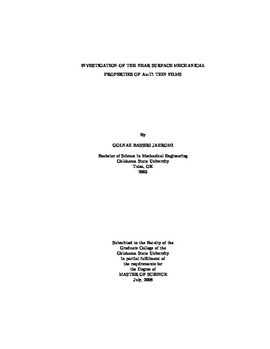| dc.contributor.advisor | Lucca, Don A. | |
| dc.contributor.author | Jahromi, Golnaz Bassiri | |
| dc.date.accessioned | 2014-04-17T19:52:33Z | |
| dc.date.available | 2014-04-17T19:52:33Z | |
| dc.date.issued | 2008-07-01 | |
| dc.identifier.uri | https://hdl.handle.net/11244/9949 | |
| dc.description.abstract | Gold is a common metal chosen for MEMS electrical contacts because of its high conductivity, ductility, inertness, and low resistivity, contact resistance and susceptibility to oxidation. However, due to the low hardness of gold, adhesion failure is prone in cycling conditions which reduces the reliability of the contacts.Motivated by the goal to create high performance electrical contacts, a systematic study on the development of modified Au films was undertaken to examine how surface and subsurface material structure affects mechanical behavior. As a baseline study, the effect of deposition rate, adhesion sublayer, and heat treatment on e-beam evaporated Au films was investigated. The co-evaporation of Au and Ti was then undertaken, due to the prominent tribological performance of Ti alloys. Various amounts of Ti, ranging from 0.7 to 20 at. % Ti, were co-deposited with Au to investigate the changes in properties caused by the formation of a solid solution or intermetallic compound.The increase in Ti content downsized the Au nodules on the surface of the films. In the Au-Ti films of 16 and above at. % Ti surface cracks were observed, indicative of increases in residual stresses. An increase in hardness was observed in the films with 16 and above at. % Ti. This increase in hardness is attributed to the formation of an intermetallic compound. Solid solution strengthening and grain refining did not affect the hardness of Au-Ti films of 0.7 - 5.6 at. % Ti. The resistivity of the Au-Ti films linearly increased by the addition of Ti. The heat treatment of Au-16.4 at. % Ti was performed to increase the diffusivity and recrystalize the intermetallic compound. The altered microstructure in the heat treated Au-16.4 at. % Ti film was accompanied by a shift from Au(111) to Au(200) consistent with a change from residual tensile to compressive stress reported in the literature. To investigate the precipitate hardening of Au 4 Ti, the Au-5.6 at. % Ti films were heat treated for various times. An increase in hardness was measured suggesting the effect of precipitate hardening and dispersion hardening within the matrix. | |
| dc.format | application/pdf | |
| dc.language | en_US | |
| dc.publisher | Oklahoma State University | |
| dc.rights | Copyright is held by the author who has granted the Oklahoma State University Library the non-exclusive right to share this material in its institutional repository. Contact Digital Library Services at lib-dls@okstate.edu or 405-744-9161 for the permission policy on the use, reproduction or distribution of this material. | |
| dc.title | Investigation of the Near Surface Mechanical Properties of Au-ti Thin Films | |
| dc.type | text | |
| dc.contributor.committeeMember | Price, C. Eric | |
| dc.contributor.committeeMember | Komanduri, Ranga | |
| osu.filename | Jahromi_okstate_0664M_2864.pdf | |
| osu.college | Engineering, Architecture, and Technology | |
| osu.accesstype | Open Access | |
| dc.description.department | Mechanical & Aerospace Engineering | |
| dc.type.genre | Thesis | |
| dc.subject.keywords | co-evaporation | |
| dc.subject.keywords | au-ti | |
| dc.subject.keywords | thin films | |
| dc.subject.keywords | nanoindentation | |
